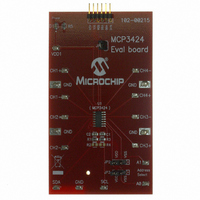MCP3424EV Microchip Technology, MCP3424EV Datasheet - Page 19

MCP3424EV
Manufacturer Part Number
MCP3424EV
Description
EVALUATION BOARD FOR MCP3424
Manufacturer
Microchip Technology
Specifications of MCP3424EV
Number Of Adc's
1
Number Of Bits
18
Sampling Rate (per Second)
3.75 ~ 240
Data Interface
I²C
Inputs Per Adc
4 Differential
Input Range
±2.048 V
Power (typ) @ Conditions
135µA @ 240sps
Voltage Supply Source
Single Supply
Operating Temperature
-55°C ~ 125°C
Utilized Ic / Part
MCP3424
Processor To Be Evaluated
MCP3424
Lead Free Status / RoHS Status
Lead free / RoHS Compliant
Lead Free Status / RoHS Status
Lead free / RoHS Compliant, Lead free / RoHS Compliant
Available stocks
Company
Part Number
Manufacturer
Quantity
Price
Company:
Part Number:
MCP3424EV
Manufacturer:
Microchip Technology
Quantity:
135
5.3.4
When the Master sends a read command (R/W = 1),
the MCP3424 outputs both the conversion data and
configuration bytes. Each byte consists of 8 bits with
one acknowledge (ACK) bit. The ACK bit after the
address byte is issued by the MCP3424 and the ACK
bits after each conversion data bytes are issued by the
Master.
When the device is configured for 18-bit conversion
mode, the device outputs three data bytes followed by
a configuration byte. The first 6 data bits in the first data
byte are repeated MSB (= sign bit) of the conversion
data. The user can ignore the first 6 data bits, and take
the 7th data bit (D17) as the MSB of the conversion
data. The LSB of the 3rd data byte is the LSB of the
conversion data (D0).
If the device is configured for 12, 14, or 16 bit-mode, the
device outputs two data bytes followed by a
configuration byte. In 16 bit-conversion mode, the MSB
(= sign bit) of the first data byte is D15. In 14-bit conver-
sion mode, the first two bits in the first data byte are
repeated MSB bits and can be ignored, and the 3rd bit
(D13) is the MSB (=sign bit) of the conversion data. In
12-bit conversion mode, the first four bits are repeated
TABLE 5-3:
© 2008 Microchip Technology Inc.
Note 1:
Conversion
Option
18-bits
16-bits
14-bits
12-bits
2:
3:
4:
D17 is MSB (= sign bit), M is repeated MSB of the data byte.
D15 is MSB (= sign bit).
D13 is MSB (= sign bit), M is repeated MSB of the data byte.
D11 is MSB (= sign bit), M is repeated MSB of the data byte.
READING OUTPUT CODES AND
CONFIGURATION BYTE FROM THE
DEVICE
MMMMMMD17D16 (1st data byte) - D15 ~ D8 (2nd data byte) - D7 ~ D0 (3rd data byte) - Configuration
byte. (Note 1)
D15 ~ D8 (1st data byte) - D7 ~ D0 (2nd data byte) - Configuration byte. (Note 2)
MMD13D ~ D8 (1st data byte) - D7 ~ D0 (2nd data byte) - Configuration byte. (Note 3)
MMMMD11 ~ D8 (1st data byte) - D7 ~ D0 (2nd data byte) - Configuration byte. (Note 4)
OUTPUT CODES OF EACH RESOLUTION OPTION
Digital Output Codes
MSB bits and can be ignored. The 5th bit (D11) of the
byte represents the MSB (= sign bit) of the conversion
data.
of each conversion mode.
The configuration byte follows the output data bytes.
The device repeatedly outputs the configuration byte
only if the Master sends clocks repeatedly after the
data bytes.
The device terminates the current outputs when it
receives a Not-Acknowledge (NAK), a repeated start or
a stop bit at any time during the output bit stream. It is
not required to read the configuration byte. However,
the Master may read the configuration byte to check
the RDY bit condition.The Master may continuously
send clock (SCL) to repeatedly read the configuration
byte (to check the RDY bit status).
Figures 5-4
reading.
Table 5-3
and
summarizes the conversion data output
5-5
show the timing diagrams of the
MCP3424
DS22088A-page 19












